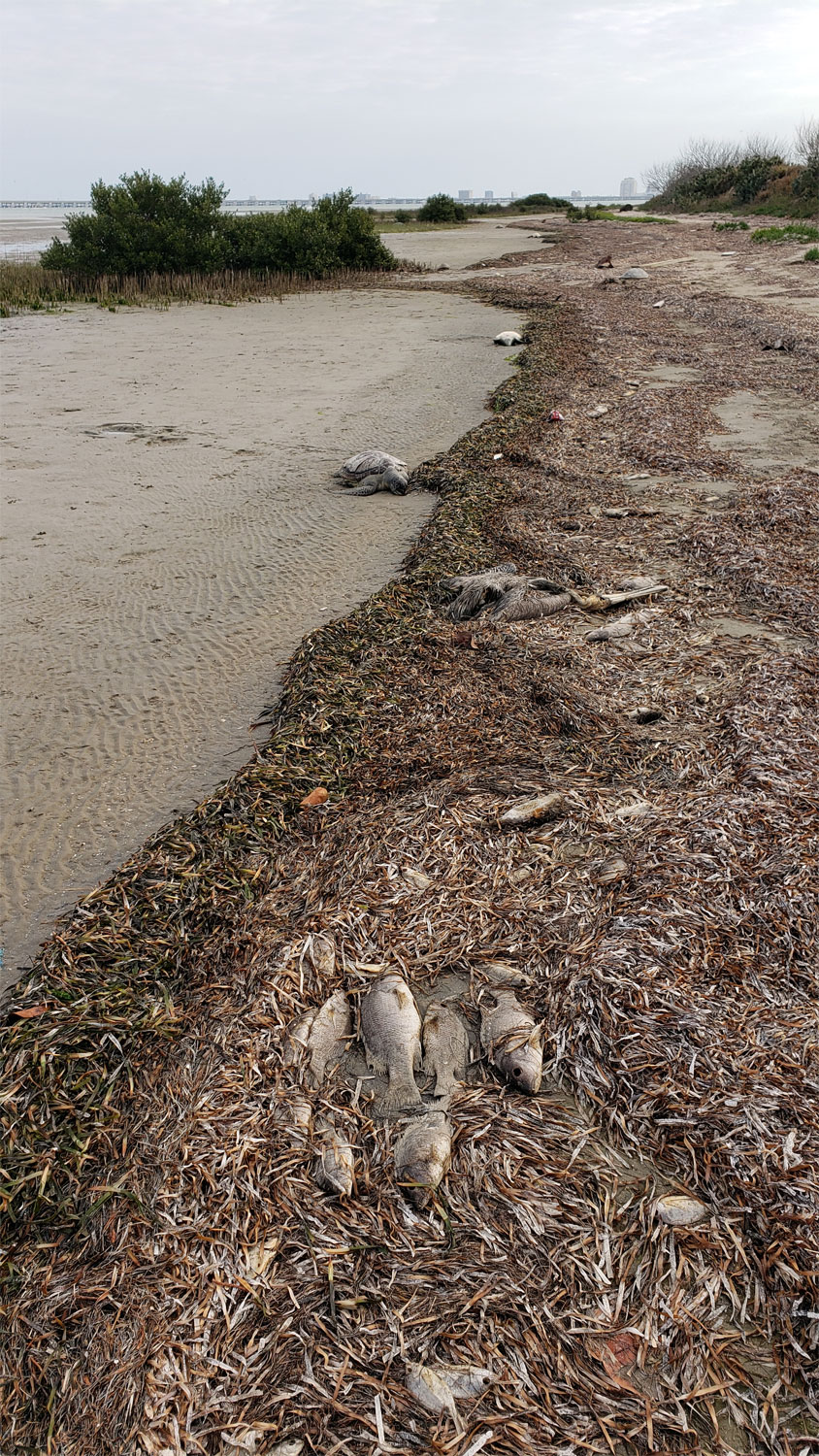The deep freeze of a month ago killed an estimated 3.8 million fish in Texas coastal waters, the fourth major weather-related fish kill on the gulf coast since 1983.
The Texas Parks and Wildlife Department surveyed coastal waters for dead fish, identifying 61 different species, and released their estimate Wednesday.
The Lower Laguna Madre, TPWD officials said, was particularly hard-hit.
“Non-recreational species contributed to 91 percent of the total mortality in numbers of fish,” TPWD said in a statement. “This includes species like silver perch, hardhead catfish, pinfish, bay anchovy and striped mullet.”
“While not sought after by most anglers, non-game fish are ecologically important, providing food for larger game fish as well as adding to the overall diversity of Texas bays,” the statement read. “Recreationally important game species accounted for the other 9 percent of the total. Of that 9 percent, the dominant species included spotted seatrout (48 percent), black drum (31 percent), sheepshead (8 percent), sand seatrout (7 percent), red drum (3 percent), gray snapper (2 percent) and red snapper ( less than 1 percent).”
The TPWD went on to say the Lower Laguna Madre had the highest mortality of spotted seatrout with an estimated kill of 104,000 fish.
On the water
“I’ve been fishing once since the freeze,” South Padre Island fishing guide Capt. Grady John Deaton said Thursday. “I did not see a lot of dead fish and saw one dead turtle, but we only caught one fish. It was a big, oversized redfish.”
“We caught no trout whatsoever,” he added. “A friend of mine went out yesterday, and he said they got five fish and only one of the five trout was big enough to keep. Fishing’s tough.”
Another Island fishing guide, Capt. Craig Woolly, said he has personally not seen much evidence of extensive fish mortality but has seen airborne footage and has heard anecdotal reports of significant fish kills in the region.
“The team at Paradise (beach condos) removed 142,000 pounds of dead mullet, and I have seen drone footage of both sides of the Arroyo Colorado up north, where to me it looked devastating,” Woolly said Thursday. “I have friends of mine who fish out of Port Mansfield and in certain areas up there they’ve seen a bunch of dead speckled trout, some redfish and lots of dead black drum. The dead black drum thing kind of surprised me more than anything.”
Woolly said one acquaintance of his is a commercial fisherman specializing in black drum, selling to local restaurants.
“I saw him at the dock, I guess early last week, and I asked him, ‘Have you been up around the gas wells?,’ that’s up around the Dunkin House or the Cullen House if you’re familiar with the bay system,” Woolly said. “That’s about 15 miles up north from South Padre Island here. And his quote was ‘millions.’”

One for the books
Previously, major fish kills due to cold weather occurred in December 1983, with an estimated 14.4 million fish dead along the entire Texas coast; in February 1989, which killed 11.3 million fish between East Matagorda Bay down to the Lower Laguna Madre; and in December 1989, 6.2 million fish were estimated to have been killed.
“I’m 60, so I’m old enough to remember the freezes of ‘83 and ‘89, and back in that time I lived in the Corpus Christi area,” Woolly said. “After the freeze of ‘89 it probably took a good four to six years for the fishing to get back just to the way it was before the freeze, and I would venture to say Parks and Wildlife is going to slash regulations big-time.”
“I’ve heard rumors of catch-and-release only for a year or two, I’ve heard rumors they’re going to cut it back to one trout, one redfish, one flounder as daily bag limits,” he added.
Current daily limits are five for trout and flounder, and three for redfish.
Re-assessing a resource
The first indication of a winter fish kill are the small fish, mullet, pinfish, sand trout, burr fish and other baitfish species, which float to the surface.
The larger fish, the ones sought by anglers, including red and black drum, spotted seatrout and snook, initially sink to the bottom and it takes a few days or a week or two for the extent of their collective fate to become visible.
Woolly said if the fishing is impacted negatively for a few years, it should be a wake-up call for sportsmen to reconsider the way they use the coastal fishing resource.
“I’m hoping that going forward from here, it’s going to be rude slap in the face to some people,” he said. “…Once they get out there, and they’ve been out there two or three times, and they’re not getting a bite much less catching a fish.”
“They’re going to start thinking, hopefully they will, maybe we need to be a little bit better stewards of what we have here, rather than having some sort of an ego picture with 25 trout and 12 reds and six black drum hanging on nails at some boat ramp somewhere,” Woolly said.




